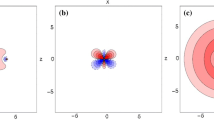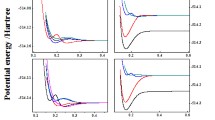Abstract
The ground and low-lying excited states of the DyCl molecule are investigated by the four-component relativistic CI methods. Electronic states are classified into so-called families by applying the f-shell Omega decomposition method to the CI wavefunctions, and the characters of the states are clarified. The X7.5 ground state may be described as Dy+[(4f)9(6s)2]Cl−, but at large nuclear distance (R > 4.80 au), beyond the equilibrium nuclear distance (4.724 au), the dominant configuration changes to Dy+[(4f)10(6s)1]Cl−. The dominant configuration of Dy+[(4f)9(6s)2]F− is retained in DyF, but the dominant configuration in DyCl changes drastically as R increases. The calculated value (231 cm−1) of the vibrational frequency (ωe) agrees well with the value of 233 cm−1 observed by Linton et al. (J Mol Spectrosc 232:30–39, 2005). This low frequency reflects the weakness of the Cl− ligand compared to F−. The Y[0.15]8.5, Z[0.85]7.5, and [0.97] states observed by Linton et al. are found to have a dominant configuration of [(4f)10(6s)1], and the A[16.4]8.5 and B[15.4]Ω states observed both have (4f)10([6p1/2,1/2])1, belonging to different families. (The number in square brackets denotes the excitation energy in unit of k cm−1, and the number after a right square bracket denotes an Ω value.) The Ω value of the B[15.4]Ω state, which has not been determined experimentally, is calculated to be 6.5.





Similar content being viewed by others
References
DIRAC, a relativistic ab initio electronic structure program, Release DIRAC16 (2016), written by Jensen HJAa, Bast R, Saue T, Visscher L, with contributions from Bakken V, Dyall KG, Dubillard S, Ekström U, Eliav E, Enevoldsen T, Faßhauer E, Fleig T, Fossgaard O, A. Gomes ASP, Helgaker T, Henriksson J, Iliaš M, Jacob ChR, Knecht S, Komorovský S, Kullie O, Lærdahl JK, Larsen CV, Lee YS, Nataraj HS, Nayak MK, Norman P, Olejniczak G, Olsen J, Park YC, Pedersen JK, Pernpointner M, Di Remigio R, Ruud K, Sałek P, Schimmelpfennig B, Shee A, Sikkema J, Thorvaldsen AJ, Thyssen J, van Stralen J, Villaume S, Visser O, Winther T, Yamamoto S. http://www.diracprogram.org. Accessed 03 Dec 2017
Hargittai M (1988) Coord Chem Rev 91:35–88
Lanza G, Varga Z, Kolonits M, Hargittai M (2008) J Chem Phys 128:074301
Roos B, Lindh R, Malmqvist P-Å, Veryazov V, Widmark P-O (2008) J Phys Chem A 112:11431–11435
Dolg M (2011) J Chem Theory Comput 7:3131–3142
Hatanaka M, Yabushita S (2014) Theor Chem Acc 133:1517
Ji W-X, Xu W, Schwarz WHE, Wang S-G (2015) J Comput Chem 36:449–458
McCarthy MC, Bloch JC, Field RW, Kaledin LA (1996) J Mol Spectrosc 179:253–262
Kaledin AL, Heaven MC, Field RW, Kaledin LA (1996) J Mol Spectrosc 179:310–319
Kaledin LA, Holbrook RT, Kunc JA (1998) J Appl Phys 83:3499–3508
Kaledin LA, Heaven MC, Field RW (1999) J Mol Spectrosc 193:285–292
Tatewaki H, Yamamoto S, Moriyama H (2015) In: Dolg M (ed) Computational methods in lanthanide and actinide chemistry. Wiley, West Sussex, pp 89–119
Moriyama H, Tatewaki H, Watanabe Y, Nakano H (2009) Int J Quantum Chem 109:1898–1904
Tatewaki H, Yamamoto S, Watanabe Y, Nakano H (2008) J Chem Phys 128:214901
Yamamoto S, Tatewaki H, Moriyama H (2012) Theor Chem Acc 131:1230
Yamamoto S, Tatewaki H, Saue T (2008) J Chem Phys 129:244505
Yamamoto S, Tatewaki H (2011) J Chem Phys 134:164310
Yamamoto S, Tatewaki H (2012) Comput Theor Chem 980:37–43
Yamamoto S, Tatewaki H (2015) J Chem Phys 142:094312
Linton C, Ghosh RK, Dick MJ, Adam AG (2005) J Mol Spectrosc 232:30–39
Fleig T, Olsen J, Marian CM (2001) J Chem Phys 114:4775–4790
Gomes ASP, Dyall KG, Visscher L (2010) Theor Chem Acc 127:369–381
Koga T, Tatewaki H, Matsuoka O (2001) J Chem Phys 115:3561–3565
Andzelm J, Kłobukowski M, Radio-Andzelm E, Sakai Y, Tatewaki H (1984) In: Huzinaga S (ed) Gaussian basis sets for molecular calculations. Elsevier, Amsterdam
Lee YS, McLean AD (1982) J Chem Phys 76:735–736
Ishikawa Y, Binning RC Jr, Sando KM (1983) Chem Phys Lett 101:111–114
Stanton RE, Havriliak S (1984) J Chem Phys 81:1910–1918
Visser O, Visscher L, Aerts PJC, Nieuwpoort WC (1992) J Chem Phys 96:2910–2919
Knecht S, Jensen HJA, Fleig T (2010) J Chem Phys 132:014108
Saue T, Jensen HJA (1999) J Chem Phys 111:6211–6222
Gotkis I (1991) J Phys Chem 95:6086–6095
Karlström G, Lindh R, Malmqvist P-Å, Roos BO, Ryde U, Veryazov V, Widmark P-O, Cossi M, Schimmelpfennig B, Neogrady P, Seijo L (2003) Comput Mater Sci 28:222–239
Saloni J, Roszak S, Hilpert K, Miller M, Leszczynski J (2004) Eur J Inorg Chem 2004:1212–1218
Dunning A, Petrov A, Schowalter SJ, Puri P, Kotochigova S, Hudson ER (2015) J Chem Phys 143:124309
Martin WC, Zalubas R, Hagan L (1978) In: Atomic energy levels–the rare-earth elements. National Standard Reference Data Series 60:261–291. US National Bureau of Standards
Huber KP, Herzberg G (1979) In: Molecular spectra and molecular structure, IV. Constants of diatomic molecules. Van Nostrand, New York
Zmbov KF, Margrave JL (1966) J Phys Chem 70:3379–3382
Dolg M, Stoll H (1989) Theor Chim Acta 75:369–386
Acknowledgements
The main computations were performed on a cluster of Intel Xeon-based computers at the Institute for Advanced Studies in Artificial Intelligence (IASAI) of Chukyo University.
Author information
Authors and Affiliations
Corresponding author
Ethics declarations
Conflict of interest
The authors declare that they have no conflict of interest.
Electronic supplementary material
See electronic supplementary material for the decomposition table generated in the f-shell Omega decomposition method.
Rights and permissions
About this article
Cite this article
Yamamoto, S., Tatewaki, H. Ground and low-lying excited states of DyCl studied by the four-component relativistic configuration interaction methods. Theor Chem Acc 137, 112 (2018). https://doi.org/10.1007/s00214-018-2296-y
Received:
Accepted:
Published:
DOI: https://doi.org/10.1007/s00214-018-2296-y




